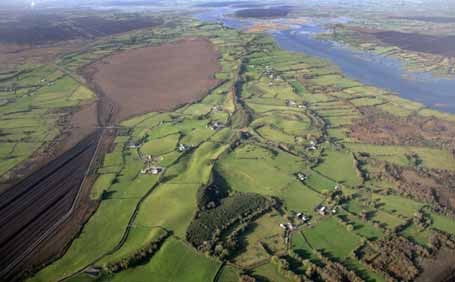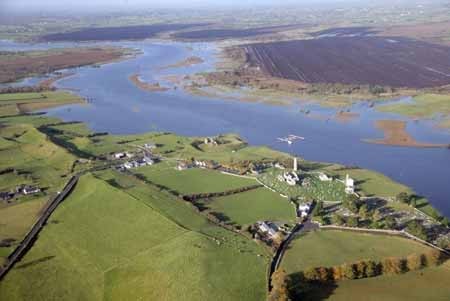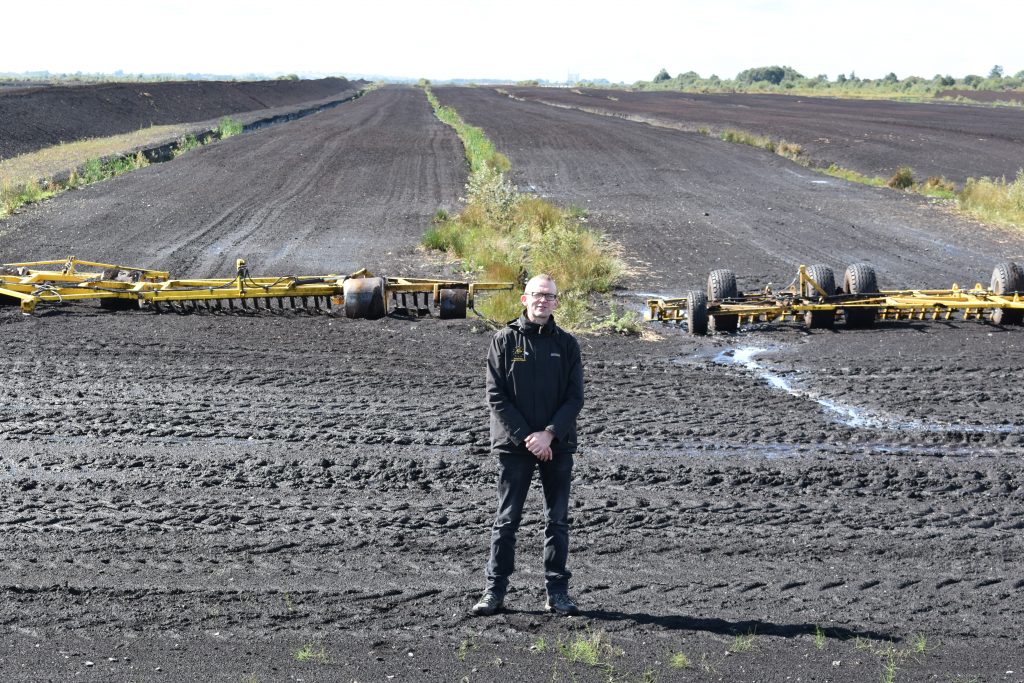At present there are no visitor facilities on Mongan Bog. We will post more on open days, guided walks and other events here and on our Facebook and Twitter pages as they arise, e.g. Heritage Week. We have organised many tours on this amazing bog.
You can take in its beauty without engaging in some bog trotting.
The bog is best-viewed from the Pilgrim’s Road, or Pilgrim’s Way, an ancient raised road along the top of the glacial ridge, or esker. From this ancient road, which brought pilgrims into (and out of) Clonmacnoise since the early seventh century, you can look down on the impressive dome of Mongan Bog. The dome may not be as high as it was when Pilgrims visited Ireland’s oldest pilgrimage site, but it is still an awe-inspiriting sight.
 The Pilgrim’s Road offered safe passage to medieval travellers to and from Clonmacnoiseis.
The Pilgrim’s Road offered safe passage to medieval travellers to and from Clonmacnoiseis.
It leads from the monastic core eastwards through the old burial ground and dissects the New Graveyard where it heads towards the Nun’s Church; a small platform of stones known as ‘the Cairn of the Three Crosses’ is visible on its route. It is a key part of the pilgrimage route at Clonmacnoise known as ‘The Long Station’ performed on the Pattern of St Ciarán.
The Pilgrim’s Way from Ballycumber to Clonmacnoise was a part of the Pilgrim Paths Project, set up by the Heritage Council in 1997, in association with local communities, with the objective of developing a network of walking routes along medieval pilgrimage paths. The aim of the project was to raise the profile of the landscape and its heritage, built and natural that is encountered along the routes, while contributing to sustainable tourism and community development in each local area. Work on the Pilgrim’s Way was completed in
2007.
The Pilgrim’s Way demonstrates how the natural attributes of the landscape were used to benefit the development of the monastic city. The Pilgrim’s Way is a further reminder of the sacral nature of the landscape around Clonmacnoise.
You can exit at Clonmacnoise, following the ‘pointer’ signs for about 1km until you reach the rise of the road overlooking Mongan. As you stand in the centre of the road with the bog over one shoulder and the River Shannon over the other, it is one of Ireland’s most impressive sights. You are truly following in the footsteps of ancient pilgrims!

Clonmacnoise is one of the most popular and historic ancient monastic sites in Ireland. A walk amongst the peaceful stone ruins of this famous place will conjure images of the saints and scholars of Ireland’s renowned Golden Age of learning.
Founded by St Ciaran in the mid-6th century, it became a great centre of religion and learning, visited by scholars from all over the world. Many historical manuscripts, including the 11th century Annals of Tighernach and the 12th century Book of the Dun Cow, were written here.

Today, the site exists as a preserved ruin under the management of the Office of Public Works and visitors can see three high crosses, a cathedral, seven churches and two round towers. The beautifully preserved structures of Clonmacnoise Cathedral, Temple Doolin, Temple Hurpan and Temple Melaghlin will impress and leave those who visit Clonmacnoise with an authentic sense of the history of Ireland.
To dig deeper into the fascinating history of Clonmacnoise, visit the on-site interpretive visitor centre, which displays a number of cross slabs and the 9th century Cross of the Scriptures. The Clonmacnoise graveyard surrounding the site continues to be in use, while religious services are held regularly on the site in a modern chapel.
Admission Prices
Adult: €8.00 | Senior/group: €6.00 | Child/student: €4.00 | Family: €20.00 |
Open all year, daily | November-Mid-March, 10:00am-5:30pm | Mid-March-May, 10:00am-6:00pm | June-August, 9:00am-6.30pm | September-October, 10:00am-6:00pm | Closed 25 and 26 December | Last admission is 45 minutes before closing.
VISIT OFFALY
For more on visiting the area, see the excellent VISIT OFFALY page on Clonmacnoise, and whilst you’re there, be sure to look around at the many places in Offaly to visit.
CROSSING THE BOGS
For people visiting Clonmacnoise, crossing the raised bogs would have been precarious as they contain permanent pools on their surface which vary greatly in depth. For this reason the eskers were preferred routes across the landscape. However, man had been interacting with this seemingly inhospitable landscape for centuries. Archaeological excavations have revealed the presence of wooden toghers (track ways) and gravel pathways across the bogs around Clonmacnoise which in many cases predate the monastery and demonstrate that the bogs were not as impenetrable as first thought.
Sadly, the drive for peat as a fuel and horticultural product has ensured that many of these have been badly damaged and/or obliterated.

Ronan Casey from the Living Bog team stands at a typical ‘production bog’ close to Clonmacnoise and Mongan Bog SAC. in Co Offaly.






